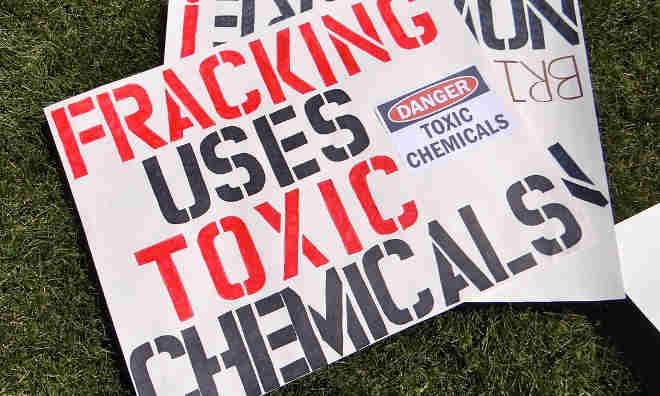In the past few years, the United States and many other nations have developed a growing interest in natural gas as an alternative to coal and oil. The number of gas drilling wells in America has nearly doubled in the past decade, and other countries, such as Australia, China, and the United Kingdom, have already started drilling. This growing interest is becoming a big problem for farmers—and everyone who depends on farmers for food—because the methods used to extract the gas often poison the environment surrounding drilling sites.
Gas drilling technology has changed significantly over the last decade. Horizontal hydraulic fracturing, or “fracking,” of gas-rich, underground shale formations enables energy companies to extract more gas from more places. Drills pump a mixture of water, sand, and chemicals into the ground to break the shale. Although fracking companies aren’t required to disclose the ingredients in their fracking fluids, a 2011 Congressional investigation found carcinogens, including benzene and other toxic diesel-based chemicals, in fracking fluid. Because fracking companies are also exempt from some federal environmental regulations, including ones in the Safe Drinking Water Act, Clean Air Act, and Clean Water Act, chemicals often leech into the environment, polluting the water, air, and land.
Veterinarian Michelle Bamberger and molecular medicine professor Robert Oswald published a report in 2012 revealing a connection between fracking and animal health. According to the report, 17 cows died in Louisiana within an hour of being directly exposed to fracking fluid, and about 50 percent of a 140-cattle herd died in Pennsylvania after fracking wastewater exposure. Scores of other animals—horses, dogs, goats—who lived near fracking rigs suffered neurological, reproductive, and other problems soon after rigs started drilling. This is thus far the only peer-reviewed study on the connections between fracking and animal health, but it can serve as an early warning to cash-strapped ranchers and farmers looking to earn money by leasing their land to oil companies.
New York, a state full of farms that sit on the gas-rich Marcellus Shale formation, has postponed its fracking decision until it can consider more studies about its environmental and health impacts. Supporters of fracking claim that extraction methods are safe and yield a reliable clean energy source, but the Sierra Club, Food & Water Watch (FWW), and the Natural Resources Defense Council are just some of many organizations that disagree. A recent report from FWW reveals that 451 of Pennsylvania’s Marcellus Shale gas wells amassed 1,544 violations of the state’s Oil and Gas Act in 2010. The report also highlights small rural towns, like Dimock, PA, that have suffered from water contamination with the onset of fracking and addresses the dangers of more and more countries pursuing fracking.
Recently, South Africa’s government lifted its moratorium on fracking with the hopes that it will be a panacea for its 25 percent unemployment rate and its dependency on fossil fuels. The Karoo Basin, known for its sheep farms, contains the fifth largest shale gas reserves in the world, which makes Shell and other energy companies eager to frack the area. Farmers in the basin are especially vulnerable because they don’t own the rights to the minerals on their property; the government does and can issue permits without consulting them. Water is scarce in the basin, which may prompt oil companies to import seawater to run the fracking drills. This could contaminate the Karoo’s groundwater, making it too salty for growing and drinking.
The FWW report notes that farmers in Argentina, Bulgaria, China, France, and Poland also do not own the rights to minerals under their land. China recently fracked its first well in the Sichuan Basin, a populous region that produces a tenth of the country’s staple foods.
As fracking spreads around the world, more farmland will likely be destroyed. And even if the oil companies can foolproof the rigs against leaks and safely dispose of the wastewater, the drilling rigs will occupy a lot of arable land. Each Marcellus Shale gas well occupies 5 to 15 acres of land, allowing 16 wells per mile, or about 1,500 in an average-sized town. According to a recent article in The Nation, at least 72,000 acres of North Dakotan land on the Bakkan Shale formation are taken up by rigs, and many more acres are devoted to fracking equipment and access roads.
According to Sierra Club President, Robin Mann, “Fossil fuels have no part in America’s energy future—coal, oil, and natural gas are literally poisoning us. The emergence of natural gas as a significant part of our energy mix is particularly frightening because it dangerously postpones investment in clean energy at a time when we should be doubling down on wind, solar and energy efficiency.” Harnessing these sources needs to be a priority before fracking ruins even more farmland.













